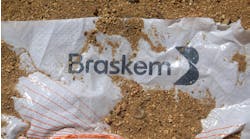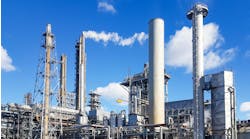Removing suspended solids from liquids is necessary in many processes. Plants generally use clarifiers for this. Clarifiers are settling tanks and, thus, often also are called settlers. In addition, the devices sometimes serve for thickening — in these cases, they are termed thickeners.
Clarifiers usually feature a built-in mechanism for continuous removal of the solids deposited by sedimentation. Concentrated impurities discharged from the bottom of the tank are known as sludge while the particles that float to the surface of the liquid are called scum. Most commonly, a clarifier comes in a circular design but rectangular and other configurations also are available.
Usually before a fluid goes to a clarifier, it undergoes coagulation and flocculation processes. These cause finely suspended particles to clump together to form larger and denser particles that settle more quickly and stably — easing the separation, improving efficiency and, thus, conserving energy. Such treatment also promotes the settling of colloids. In addition, isolating particle components first using these processes may reduce the volume of downstream treatment operations like filtration.
[callToAction ]
After coagulation, flocculation by large mechanical paddles allows coagulates to form denser particles or flocs that settle more easily. The stream then goes to the clarifier where separation of clarified liquid from the solids and flocculated coagulate occurs by permitting the heavier and larger particles to settle to the bottom. Particles form a layer of sludge requiring regular removal and disposal. Clarifiers usually incorporate mechanical solids-removal devices that move as slowly as practical to minimize re-suspension of settled solids. Clarified liquid often is pumped to filters to eliminate any residual particles; filtered liquid then flows to the next process.
Tanks are sized to give liquid an optimal residence time. Economy favors using small tanks but if the liquid flow rate through the tank is too high, most particles won’t have sufficient time to settle. Considerable attention is focused on reducing liquid inlet and outlet velocities to minimize turbulence and promote effective settling throughout available tank volume. Baffles prevent fluid velocities at the tank entrance from extending into the tank; overflow weirs uniformly distribute flow from liquid leaving the tank over a wide area of the surface to minimize re-suspension of settling particles.
Design and Operation
Control of liquid flow into a clarifier is important. Reducing the velocity increases the hydraulic retention time inside the clarifier for sedimentation and helps to avoid excessive turbulence and mixing, thereby promoting the effective settling of suspended particles. The inlet flow also should be distributed evenly across the entire cross-section of the settling zone inside the clarifier; as a very rough indication, the settling zone’s volume often is around 30–40% of total capacity of a clarifier.
The sludge formed from the settled particles at the bottom of the clarifier, if left for an extended period, may become gluey and viscous, creating difficulties in its removal. Using gas (or other means) to free the sludge can cause the re-suspension of particles and the release of dissolved materials throughout the liquid, reducing the effectiveness of the clarifier. This sludge should be drained properly from the bottom of the tank — usually this involves using specially designed positive-displacement pumps.
Two dominant forces act upon the solid particles in clarifiers: gravity and particle interactions. Too high a flow can lead to turbulence, hydraulic instability and potential flow short-circuiting. Improvements and modifications made during the last few decades, particularly for improving the separation process, have enhanced clarifier performance. For instance, installation of specially designed perforated baffle walls (based on advanced hydrodynamic simulations) promotes flow uniformity.
The clarifier mechanism is designed for constant operation. Therefore, reliability of its components, particularly mechanical and moving parts, is crucial. A clarifier should include an access walkway to the platform in the center of the basin where the mechanism is mounted. That mechanism generally is of the center drive type. Flow usually enters the center draft tube through a horizontal influent pipe extending from the tank sidewall, although peripheral and other feed designs sometimes are used. The drive unit should be capable of producing and withstanding peak momentary torque for the rake drive. As a minimum, the system should be able to provide two or three times the running torque; this is necessary particularly for starting.
Large applications that would require a single basin with a diameter in excess of 70 m instead commonly use multiple clarifiers in an “n+1,” (e.g., 2+1 or 3+1), “n+2” or similar configuration because of operational, process, reliability or layout reasons. In such arrangements, the system is designed so that flow diverted to other clarifiers when taking one clarifier (for +1) or two (for +2) out of operation doesn’t increase the surface overflow rate and the solids loading rate beyond the normal acceptable levels.
Rectangular Clarifiers And Tube Settlers
The removal of accumulated solids sometimes is easier with conveyor belts in rectangular tanks. In addition, elongating and narrowing of the tank can stabilize flow. As a result, rectangular clarifiers may provide high efficiency and low running cost.
A commonly used design is the tube settler. It increases the settling capacity by reducing the vertical distance a suspended particle must travel. High efficiency tube settlers use a stack of parallel tubes, rectangles or flat pieces separated by several centimeters and sloping upwards in the direction of flow. Such a design creates a large number of narrow parallel flow pathways that encourage uniform laminar flow.
Tube settlers can provide a large surface area onto which particles may fall and become stabilized. In addition, flow temporarily accelerates between the plates and then immediately slows down, which helps to aggregate very fine particles that can settle as the flow exits the plates. Structures usually are inclined between 45° and 60°. This may allow gravity drainage of accumulated solids but shallower angles of inclination typically require periodic draining and cleaning (or possibly use of a backwash system in special cases). Tube settlers may permit the use of a smaller clarifier and may enable finer particles to be separated with residence times less than conventional ones — even sometimes 10–30 minutes. Typically such designs handle difficult-to-treat liquids, especially those containing colloidal materials.
Tube settlers capture the fine particles, allowing the larger ones to travel to the bottom of the clarifier in a more uniform form. The fine particles build up into a larger mass that then slides down the tube channels. The decrease in solids present in the outflow enables a reduced clarifier footprint. Some applications use tubes made of polyvinyl chloride or another plastic; this affords cost savings and also sometimes improves performance.
Inclined-Plate Clarifier
An inclined-plate or “lamella” clarifier uses inclined plates for the settling process and solid separation. These inclined plates provide a large effective settling area for a small footprint.
A typical design consists of a series of inclined plates inside a vessel. The liquid stream enters from the top of the vessel and flows down a feed channel underneath the inclined plates; liquid then flows up inside the clarifier between the inclined plates. During this time, solids settle onto the plates and eventually fall to the bottom of the vessel. At the bottom of the vessel, a hopper or funnel collects these particles as sludge. Sludge may be continuously or intermittently discharged. Above the inclined plates all particles have settled, producing clarified liquid that is drawn off into an outlet channel by weir. The clarified liquid exits the system in an outlet stream.
Inclined-plate clarifiers are ideal for applications involving fine-sized solids whose loading varies. Such units are more common than conventional clarifiers at certain industrial sites due to their smaller footprint and better overall cost. The units also often are favored for revamp and renovation projects.
One specific application is at the pretreatment stage for liquid entering some filters. Indeed, inclined-plate clarifiers are considered one of the best options for pretreatment ahead of membrane filters. Their all-steel design means the chance that part of the inclined plate will chip off and be carried over into the filter is low, especially compared to tube settlers constructed of plastic or large concrete body conventional clarifiers. Moreover, lamella clarifiers can maintain the required liquid quality to the membrane filters far better than other designs.
In general, a key advantage of inclined-plate clarifiers over other clarifying systems is the large effective settling area created by the use of the inclined plates. This improves the operating conditions of clarifiers in a number of ways. The unit is more compact, usually requiring only 60–75% of the area of clarifiers operating without inclined plates. Therefore, a lamella clarifier system is preferred where site footprint constraints are a concern. The reduced required area may allow the clarifiers to be located inside, avoiding the common problem of clogging faced by outdoor equipment due to blowing debris accumulation. This is a great advantage for some applications. Operation within an enclosed space also enables better control of operating temperature and pressure as well as overall operating conditions. The inclined plates mean the clarifier can operate with an overflow rate two to four times that of traditional clarifiers — allowing a greater influent flow rate and, thus, a more-time-efficient clarification process.
Inclined-plate clarifiers boast a simple design without any moving parts. Thus, the units have a much lower propensity for mechanical failure than other clarifiers, which results in safer and more reliable operation. In addition, these devices usually don’t require use of chemicals for the clarifications and solid separation. So, they can act as pretreatment for delicate filter processes.
While inclined-plate clarifiers can overcome many difficulties encountered by the use of more traditional clarifiers, they do pose some disadvantages. Lamella clarifiers can’t treat most raw liquid mixtures, which need some pretreatment (e.g., fine screening) to remove materials that could decrease separation efficiency. In addition, the layout of the clarifier creates extra turbulence as the liquid turns a corner from the feed to the inclined plates. This area of increased turbulence coincides with the sludge collection point and the flowing liquid can cause some re-suspension of solids while simultaneously diluting the sludge. This results in the need for further treatment to remove the excess moisture from the sludge. Clarifier inlets and discharge should be designed to distribute flow evenly.
Regular maintenance is required because sludge flows down the inclined plates, leaving them dirty. Frequent cleaning helps prevent uneven flow distribution that reduces the efficiency of the process. The closely packed plates make the cleaning difficult. However, removable and independently supported plates can be installed. A number of proprietary inclined-plate clarifier designs exist. Inclined plates may be based on circular, hexagonal or rectangular tubes. As a rough guideline, plate spacing typically is around 50 mm and plate length is 1–2.5 m. The minimum plate pitch is about 10°. Pitches between 45° and 70° allow for self-cleaning. Lower pitches require cleaning via backwash of liquid flow.
Overall, while inclined-plate clarifiers may offer cost, footprint or performance advantages for specific applications, they are not as good an option as conventional clarifiers for most services.
A Specific Application
Let’s consider a brine clarifier (brine settler) for a chemical plant. The density of brine was around 1.18 times that of water; feed solid was around 1,000 ppm; liquid feed flow was estimated at about 50 m3/h. This led to the selection of a circular-type conventional clarifier. It was targeted to produce overflow liquid with around 30 ppm or less of solids. In other words, 97% of solids should settle in the clarifier and only 3% (or less) of solids should leave with the treated overflow liquid. The brine clarifier has a 17-m diameter, around 5.5-m elevation, about 10-m overall elevation, and a 6° bottom slope. It was fabricated from carbon steel and lined with 5 mm of rubber for corrosion protection; its roof was made from fiber-reinforced polymer. It provides a retention time of around 17 hours.
AMIN ALMASI is a rotating equipment consultant based in Sydney, Australia. Email him at [email protected].


